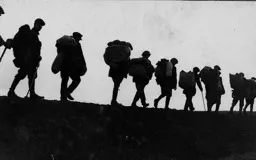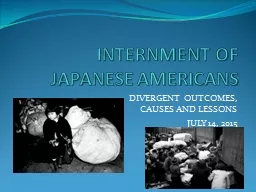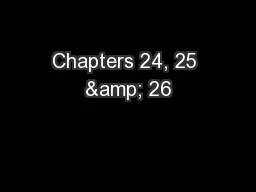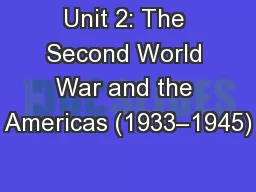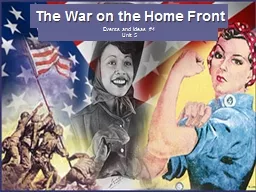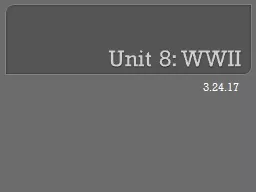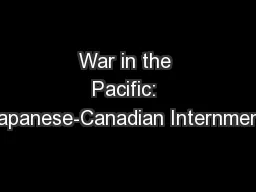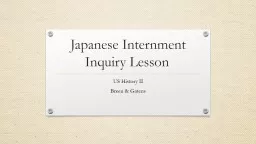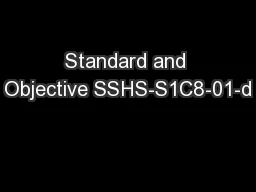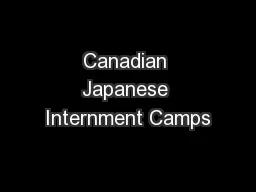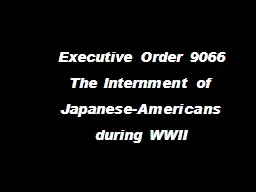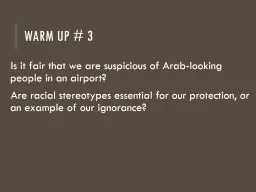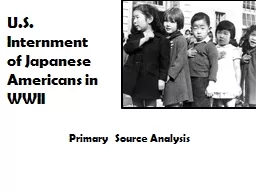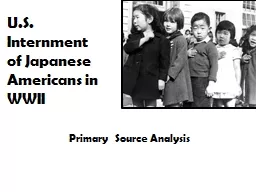PPT-Watch and Wonder: Revisiting Japanese-American Internment
Author : giovanna-bartolotta | Published Date : 2018-03-23
Video Clip httpbitly2u9Od9W Compelling Question What was it like to be a GermanAmerican in Ohio during WWI Activity Providing Deeper Context with Newspaper Analysis
Presentation Embed Code
Download Presentation
Download Presentation The PPT/PDF document "Watch and Wonder: Revisiting Japanese-Am..." is the property of its rightful owner. Permission is granted to download and print the materials on this website for personal, non-commercial use only, and to display it on your personal computer provided you do not modify the materials and that you retain all copyright notices contained in the materials. By downloading content from our website, you accept the terms of this agreement.
Watch and Wonder: Revisiting Japanese-American Internment: Transcript
Video Clip httpbitly2u9Od9W Compelling Question What was it like to be a GermanAmerican in Ohio during WWI Activity Providing Deeper Context with Newspaper Analysis Instructions. Hajdasz. . JFK Middle School. . Utica City School District. . Khajdasz@uticaschools.org. Japanese-American Internment. After the attack on Pearl Harbor, many Americans questioned the loyalty of Japanese Americans, fearing they may act as spies or help Japan invade the U.S.. DIVERGENT OUTCOMES, CAUSES AND LESSONS. JULY 14, 2015. INTERPRETATIONS. VERSION ONE:. INTERNMENT WAS FUNDAMENTALLY THE PRODUCT OF BROAD, DAMNING FACTORS WITHIN THE AMERICAN POPULATION WITH RACISM FOREMOST AND ECONOMIC RIVALTY, XENOPHOBIA, AND TERROR OVER JAPANESE MILITARY SUCCESSES AS CONTRIBUTORY FACTORS.. World War II. From Isolation to War. - Congress further prevented international involvement by passing a series of . Neutrality Acts. . - The 1st Neutrality Act prevented the US from providing weapons to nations at war.. Bullet 4 - . Treatment of Japanese Americans, Japanese Latin Americans and Japanese Canadians . Treatment of Japanese Americans. Anti-Japanese . feeling from most, but not all Americans took place after that Japanese attack on Pearl Harbor in December 1941. Events and Ideas #4. Unit 5. Essential Question. Was Japanese interment just during a time of war. ? Why or why not?. Compare and contrast life during WWII to life today.. Contains . these Videos:. Episode #35 – . 3.24.17. Timeline. Review the major events of Japanese-American internment & . talk with . your row. :. What do you know about Japanese-American internment?. What surprises you about the timeline?. & The Atomic Bombs. Internment Camps. War Measures Act. : waiving of habeas corpus and right to trial, bans on political and religious groups, restrictions of free speech, confiscation of property and…. US History II. Breen & Gatens. Warm Up. You will be answering the question, “. Why were . Japanese Americans . interned during World War II. ?”. What does internment mean? -. the . state of being confined as a prisoner, especially for political or military . Strand 1: American History. Concept 8: Great Depression and World War II. PO 2. Describe the impact of American involvement in World War II:. d. Japanese, German, and Italian internments and POW camps. War on the Home front. QUESTION 1: . What is more important to you: Civil liberties (democracy, individual freedoms, rights etc.) OR National Security. QUESTION 2:. Would this change during war? Why or why not?. Japanese-Americans . during WWII. FDR orders the relocation of people of Japanese descent from the west coast to temporary camps in the interior of the country for national security. .. Over 120,000 people were imprisoned . Are racial stereotypes essential for our protection, or an example of our ignorance? . Japanese American Internment. Background Details. Executive Order 9066. Issued by FDR in February 1942. Relocated nearly 120,000 Japanese Americans – 62% of whom were American citizens. Americans in. WWII. Primary Source Analysis. in·tern·ment. . n. .. . 1. . The act of interning or confining, especially in wartime.. 2. . The state of being interned; confinement. Public notices were posted announcing that all Japanese Americans – even those with as little as 1/16th Japanese blood – had 48 hours to sell their property and possessions and gather at assembly points. . Americans in. WWII. Primary Source Analysis. in·tern·ment. . n. .. . 1. . The act of interning or confining, especially in wartime.. 2. . The state of being interned; confinement. Public notices were posted announcing that all Japanese Americans – even those with as little as 1/16th Japanese blood – had 48 hours to sell their property and possessions and gather at assembly points. .
Download Document
Here is the link to download the presentation.
"Watch and Wonder: Revisiting Japanese-American Internment"The content belongs to its owner. You may download and print it for personal use, without modification, and keep all copyright notices. By downloading, you agree to these terms.
Related Documents

